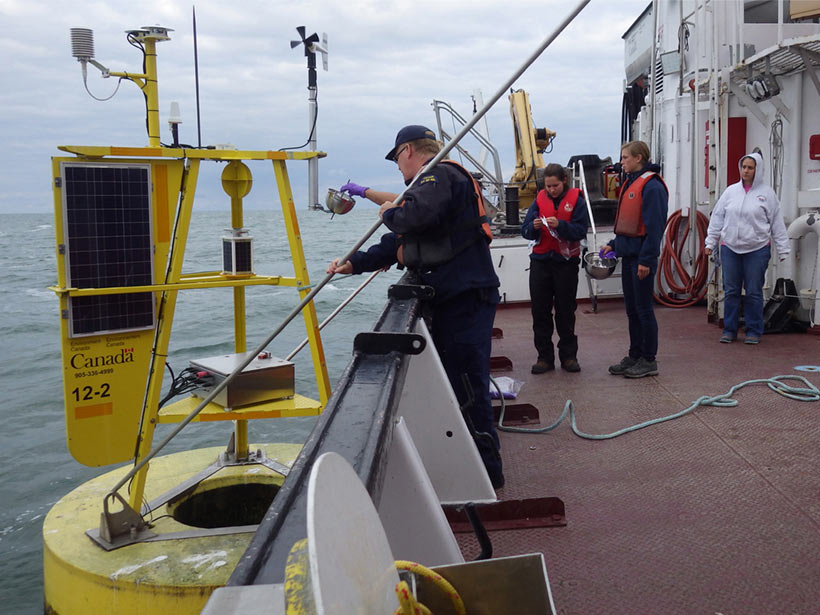Despite growing recognition of the role of inland waters in the global carbon cycle, scientists have paid scant attention to the movement of carbon in and out of the Great Lakes. Seeking to fill in some of the blanks about these lakes, which rank among the world’s largest, researchers have now made initial efforts to quantify methane emissions from Lake Erie. The methane trackers report that the lake is pumping out as much as 130,000 kilograms of methane each day in late summer—nearly a third of which might be the result of underwater natural gas drilling.
The lake is pumping out as much as 130,000 kilograms of methane each day in late summer.
Amy Townsend-Small, a geochemist from Ohio’s University of Cincinnati, and her colleagues measured the flow of methane from Lake Erie’s surface into the air in late summer of 2012 and 2013 and took water samples at various depths and in various seasons. Researchers from Environment and Climate Change Canada collaborated on the study, which was published this month in the journal Limnology and Oceanography.
Tracing Methane Sources
Kilogram for kilogram, the powerful greenhouse gas methane drives atmospheric heating about 34 times more strongly than carbon dioxide does. In Lake Erie, recurring algae blooms—like the one that left the city of Toledo without safe drinking water for 2 days in 2014—produce the bulk of the lake’s methane emissions, according to Townsend-Small.
The cause is algal decomposition. “After the algae die, they sink to the bottom, and the algae’s carbon is consumed through respiration by fish and other organisms using oxygen, so oxygen gets depleted,” she explained. The resulting oxygen-poor environment favors methane-producing microbes in the sediment at the lake’s bottom.
Efforts in the 1970s and 1980s succeeded in reducing the frequency of these algae blooms by reducing phosphorous inputs into Lake Erie, but today, the frequency of blooms is on the rise again.
The lake’s Canadian waters also host more than 2000 active and inactive underwater natural gas wells, which have the potential to leak methane into the water. Methane from algal breakdown contains different ratios of carbon and hydrogen isotopes than the methane from commercial gas production, giving researchers a way to tease apart how much each source contributes to the lake’s total methane output.
Year-Round Emissions
Townsend-Small and her colleagues measured surface flux at 14 locations in eastern and central Lake Erie in September 2012 and at 10 more widely distributed sites in August 2013. They also took samples for isotopic analysis at locations around the lake at various depths and in different seasons in 2012, 2013, and 2014.
Currents, winds, and rough water make large lakes such as Lake Erie difficult to study. When gusts repeatedly flipped over floating chambers that the researchers used to measure methane flux, the team switched to calculating flux on the basis of water temperature, wind speed, and the methane concentration of surface water, Townsend-Small told Eos. From their measurements, the scientists found that Lake Erie releases methane at almost every site they visited.

“The emissions were higher than we expected,” said Townsend-Small. “The assumption is that in large lakes methane that’s produced in the sediment is oxidized before it reaches the atmosphere, but our work is showing that that’s not the case in Lake Erie.”
Among the Great Lakes, Lake Erie ranks last in depth. It averages only 19 meters from top to bottom, so methane rising from below can relatively easily escape into the atmosphere rather than get converted into carbon dioxide.
The isotope composition of the samples suggested that most of the gas comes from natural sources, but leaks from natural gas drilling infrastructure also contribute. Naturally produced methane tends to get emitted at the beginning of autumn when cooled surface water sinks and displaces bottom water. However, the new study shows that emissions from natural gas wells could cause the lake to be a methane source year-round.
“This is one of the first comprehensive surveys of methane from a large lake and suggests that both biogenic and human sources of this gas are larger than expected,” commented Ankur Desai, a climate scientist from the University of Wisconsin–Madison who wasn’t involved in the new research. “That said, it’s still based on preliminary measurements at strategic points in space and time as it’s quite difficult to measure the entire lake.”
Self-Reinforcing Cycle
As climate change intensifies, Lake Erie could get locked into a self-reinforcing cycle of increasing methane emissions.
As climate change intensifies, Lake Erie could get locked into a self-reinforcing cycle of increasing methane emissions, Townsend-Small and her colleagues suggest in their paper. Stronger spring storms in the Lake Erie watershed spurred by the warming climate will likely cause more agricultural runoff and more frequent algae blooms, they write. More blooms would, in turn, lead to more methane production, contributing to further climate change.
—Rebecca Heisman, Freelance Science Journalist; email: [email protected]
Citation: Heisman, R. (2016), Algae blooms and gas wells drive Lake Erie methane emissions, Eos, 97, doi:10.1029/2016EO049225. Published on 29 March 2016.
Text © 2016. The authors. CC BY-NC-ND 3.0
Except where otherwise noted, images are subject to copyright. Any reuse without express permission from the copyright owner is prohibited.

